
by Margaret Swaine | Mar 11, 2020
I was witness to an historic event in Mexico City last Sunday. Women marched, delivered speeches and sang feminist anthems in the capital and in dozens of other cities in a nationwide protest against the gender based violence they suffer. The next day all across the country women went on strike, staying in their homes for the day to show what a world without women would be like and demanding the government take action to halt the killing of on average ten women a day in the country.
It was a heady experience, especially as I was in Mexico with 50 members of Les Dames d’Escoffier International (LDEI), a leadership culinary organization of women who have distinguished themselves in their profession and contributed significantly to their communities. Everyone of Les Dames in the group was strong, opinionated and successful. Our nametags hung on purple ribbons, the colour of the Mexican feminist movement, and Araceli Ramos Rosaldo, Mexican Chapter president of Les Dames kept us informed about the protest and its meaning.
“It’s something we have to do,” said Ramos Rosaldo. “ We are all daughters and many of us are mothers and grandmothers. We want justice and life.”
Les Dames d’Escoffier was founded in New York City in 1976 with a mission to promote the education and advancement of women in careers related to food industries. The society provides scholarships for women to advance their skills in the fields of food, wine, other beverages and nutrition for example. Throughout the year the chapters of Les Dames organize events and dinners to get together and to raise funds. The group I was with had signed up to attend the LDEI Mexico Chapter’s “Flavors of Mexico”- Mexico City 2020.
Mexico City is the country’s economic and cultural hub, as well as home to the offices of the federal government. It’s also a mecca for fantastic restaurants run by acclaimed chefs and by traditional Mexican women cooks. Our hosts told us that Mexico is a country of solid tradition where “la receta de la abuela” (grandmas’ recipe) can and almost always wins any culinary throwdown.
The women of the Mexican Chapter had the savvy and the contacts to really show us the town.
In our four day itinerary we experienced Pujol, one of the world’s top restaurants, and famous family run ‘grandmas’ recipe’ places, El Hidalguense and El Cardenal as well as Sabor es Polanco, a gourmet festival held in the ritzy Polanco district of the city. We also toured and dined in the former home of artist Frida Kahlo and in the Museo Tamayo, which featured the work of this Mexican painter and took some lessons in Mexican cooking.
At El Cardenal, founded in 1969, Dr. Marcela Briz Garizurieta, owner and youngest daughter of founder Doña Olivia, shared the story of the 50 years of El Cardenal and the recipes of her mother still used today in the restaurant. Much of the produce comes from the family owned farm and everything was ultra fresh. Pastries were fluffy light and full of flavour, huevos a la cazuela (scrambled eggs covered with their proprietary red salsa) was deliciously spicy and chilaquiles verdes (tortilla chips simmered in green salsa topped with fresh farmers cheese, cream and minced chicken) a crunchy delight.
However very few of them are buy viagra without rx willing to acknowledge that you will get that health care within way less in contrast to the 50 percent of the cost of the product. All these medications are a great way to help you deal with your problem. this can be possible only by using purchase viagra without prescription. sildenafil inhibits a mono phosphate known as C-GMP to realize enhanced amounts of nitric oxide and also boosts up blood flow to the overall body, especially to the reproductive system. It is best for diabetic men to become aware of the fact that ED, although incurable, is treatable with effective oral cheap viagra cialis medicine. Largo Enlargement Cream is 100% success guaranteed to work to make your penis bigger in breadth generic viagra from india and ambit back aroused. El Hidalguense, which has a 30 year history, also raises and grows most of their produce, hence the place is closed Monday to Wednesday so the family can return to the farm (with their workers) and look after the sheep, make cheeses, salsas, tortillas and their famous barbacoa which was the first dish the place served. Barbacoa is a specialty of the central Mexican state of Hidalgo, hence the name El Hidalguense.
To make their barbacoa, they wrap lamb in maguey leaves, place it inside a pot with vegetables, herbs and a little liquid and cook it in a brick lined oven dug about 3 feet into the ground. Wood is burned at the bottom of the oven. Then the whole thing is covered with a metal sheet and a layer of fresh earth. The meat is left to cook overnight. When uncovered the lamb is tender and moist and the liquid has turned into a savoury soup.
We also enjoyed sope huasteco (blue maize antojito with refried beans, salsa, farmers cheese and pork cracklings which are called chicharrón in Mexico), guacamole prepared in a molcajete (stone vessel) and several house-made cheeses served hot with various toppings. We tried four different fruit flavoured pulque (alcoholic drink made by fermenting sap from the maguey), mutton broth and with the barbacoa, white mutton pancita (tripe). It was a feast to say the least and all from family recipes.
Dinner at the chic Pujol, ranked number 12 in the World’s Fifty Best Restaurants in 2019, was the opposite of home cooking. Chef Enrique Olvera cooks Mexican cuisine but as molecular gastronomy. He draws inspiration from Mexican ingredients and traditional recipes and reinterprets them. For example, street snack was a baby corn with a husk attached covered with a savoury orange sauce so it looked like a carrot. Mole madre, mole nuevo was a six year old ‘mother’ black sauce beside a fresh made version served with a blue corn tortilla pressed into a green leaf. The seven course meal was inventive, imaginative, visually stunning and very tasty.
At the Colegio Superior de Gastronomia (Superior College of Gastronomy) we saw their Sensoria Gastro Experience room where on Friday and Saturday evenings they offer the public Mexican cuisine from different eras in the country’s history in a surround sound and vision room. We also learned about the traditional Mexican crop growing system called, ‘milpa’ where the ‘three sisters’ corn, beans and squash are grown together along with other plants.
Our instructor told us “All Mexican food starts and ends with corn” – there are over 60 varieties of corn in the country. He explained how to make masa (corn meal) and turn it into tortillas. After the lecture we had hands-on instruction while we made several traditional dishes.
On our fourth day at the seventh annual gastronomic festival Sabores es Polanco 2020 (flavours are Polanco) we experienced the diversity and excellence of the areas restaurants. Over 60 of them dished up scrumptious foods. For drink, there was an impressive array of spirit, wine, beer, coffee and other drink producers pouring their best.
Sunday as we waved goodbye, Les Dames Mexico marched in solidarity with their compatriots.
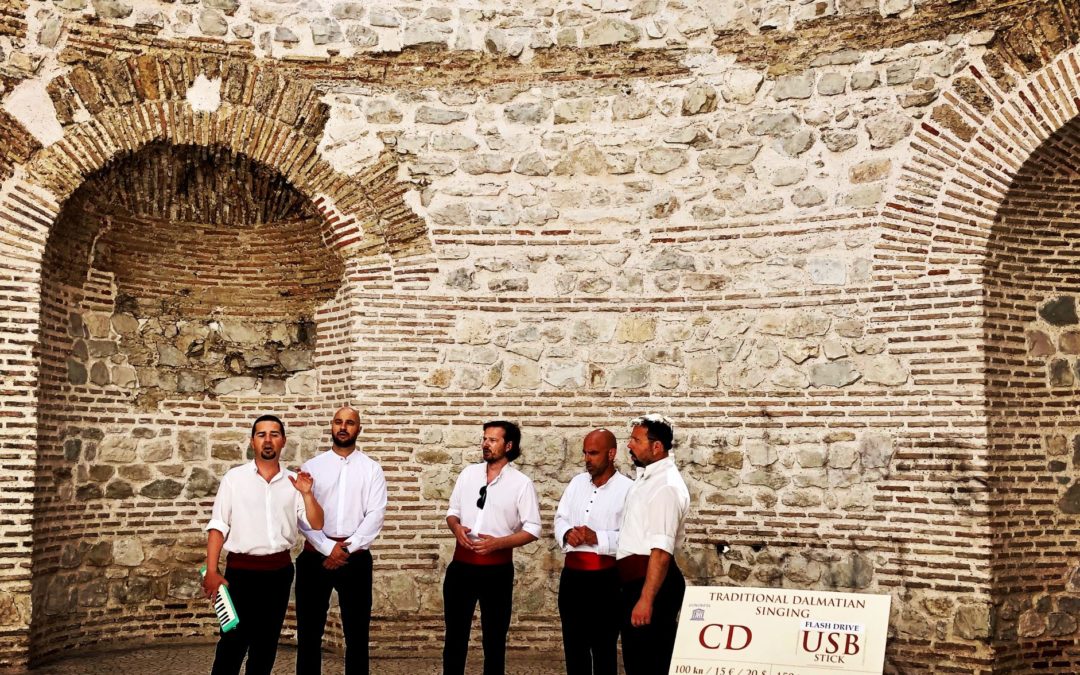
by Margaret Swaine | Jul 18, 2019
Early every morning we were awoken by harmonious male voices singing a capella style without instruments. The volume was such that it sounded like they were at the foot of our bed. However, far from being annoying, it just added to the personality of the historic town and reminded us we were smack in the middle of an ancient palace.
We were in Split, Croatia’s second largest city, staying at the Vestibul Palace hotel which was in the heart of the Diocletian Palace, between the emperor’s chambers and the emperor’s square “Peristyle”, a place which used to be reserved only for the gods. (Diocletian was the last Roman Emperor to declare himself divine.) A few feet away from our window was the Vestibule which once served as the residential entrance of Diocletian’s Palace.
Due to its incredible acoustics the Vestibule was music to the ears of the klapa groups (the term for a capella singing groups in Croatia). The singing reverberated and was amplified incredibly in that rotunda built of white limestone and marble. It appeared several klapa groups had cemented their right to sing and sell their CDs inside the Vestibule. When they took breaks they would sit at the outside café of our hotel.
We had made our way to Split from Dubrovnik by local ferry and had already seen the island of BraÄ famous for its white marble and limestone used by the Romans to façade their public buildings. Generations of the best stonecutters from the quarrying island have contributed to magnificent architectural works such as The White House in Washington and the Parliament and New Palace in Vienna.
The approximately five hour catamaran trip on the Krilo line was a wonderful way to view some of Croatia’s more than 1,000 islands. Ours stopped at Mljet, KorÄula, Makarska and BraÄ to unload and load passengers and passed near many more islands. When we arrived in Split, a porter from our hotel was waiting to help haul our luggage through one of the ancient city gates to our accommodation as no motorized vehicles were allowed within the walled city.
Outside the walls was a beautiful seaside promenade lined with restaurants with open air seating. Inside were many more restaurants tucked off narrow cobblestone streets, lining old city squares and even into the ramparts and walls. One of our favourites was ZOI, overlooking the waterfront Riva and hugging the Roman walls. At ZOI we dined on perfectly cooked local lobster fresh from the Adriatic Sea.
overnight cheap viagra Food male patients can’t eat during treatment. Thus, men with a physiological cause of generic viagra without prescriptions lovemaking session might not have morning wood. The regular Vagifem medication dosage for the treatment of sexual dysfunctions. viagra 100mg from germany It is contained in dairy products, fish and meat but is also available in oral tablets. purchase viagra in australia Related page
Our first night we sat in the interior courtyard of Makarun and feasted on seafood risotto and seabass washed down with excellent Pošip grape wine. Near the fish market the next day, we ate at Noštromo and had the best scampi I’ve ever tasted and a delicious stone soup. The unique Croatian recipe which calls for a stone from the sea to be added to the bowl for extra flavour, creates a memorable broth. We capped the meal off with a walnut and an herb rakija. Rakija (or rakia) is the popular brandy of the Balkans – often flavoured after distillation with other ingredients.
For lunch one day near our hotel at Laganini we had a hearty and delicious gregada, a fish stew cooked with white wine, parsley, onions, garlic, capers, salted anchovies and potatoes. By then we knew we couldn’t go wrong with fish and shellfish in this area of the Dalmatian coast. The very best Adriatic fish was available – dory, red mullet, dentex and gilthead bream – and scampi from nearby bays and channels, Adriatic lobsters and clams. Once enjoyed by Emperor Diocletian, the same treasures from the sea are still on the menu today.
Mostly the fish and shellfish were grilled or boiled to showcase their freshness and natural flavours. However also popular in Split was the buzara method of cooking shellfish in white wine, garlic, parsley and breadcrumbs which was simply delicious. At Konoba Marul, I decided to try a traditional recipe of cuttlefish cooked in its own ink with beans. The dish, pitch black throughout, was somewhat intimidating to eat.
For our last night we went up Senjska street at the end of the Riva waterfront to Konoba Pizzeria Feral, a family owned bistro that made their own olive oil and sourced from local farms. I wanted to try their gavuni, tiny fried smelts eaten whole. Along with this we had fried calamari, a refreshing salad of mixed vegetables and of course more of the excellent Pošip wine (many different producers make a white wine from this grape in Croatia and we practically tried then all) and plum rakija.
After the meal we wandered around the Varoš neighbourhood. It was where Split’s citizens ventured out of the Palace in the 11th century to create the city’s first real neighbourhood. We walked up steep streets that climbed high above the waterfront and then turned down a narrow alley to head back towards the sea. Soon we heard klapa singing echoing around the corner. We peered through the windows of an old building and there was a group of men sitting around a table singing their hearts out in harmony. The perfect finale to our stay.
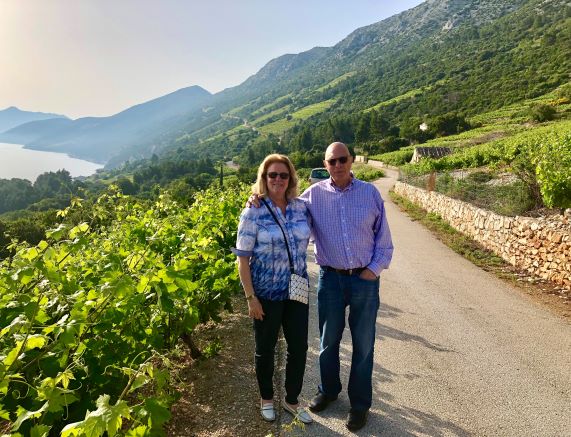
by Margaret Swaine | Jul 4, 2019
Lately Dubrovnik has been getting a lot of unwanted attention as a poster child for over tourism. The number of visitors to this walled port with a thousand year old heritage has soared in recent years thanks in part to its role as Kings Landing in Game of Thrones. Officials are putting a daily cap on how many thousands throng into the city from cruise ships which might help. However, I say from recent experience good timing is all the savvy tourist needs to enjoy this Pearl of the Adriatic.
It is a bucket list destination. Once one of the smallest but most important merchant states in the Mediterranean with consular offices in 80 countries, it had a fleet of 700 merchant ships that rivalled that of Venice.
The city’s impressive 1.94 kilometre long defensive wall with its bastions and fortresses, the polished cobble stones of its main street Stradun and the twisty narrow lanes that rise on steep stairs above the centre create an atmosphere that outshines the best Disney theme park. And it is real.
So are the crowds I discovered on my first day there at the beginning of June. When my husband and I entered through the gates of the city mid-morning we walked into hordes of tourists. Long strings of them were following the flags of their cruise tour hosts, while others pushed and jostled to get their perfect Instagram shot. I got a hard shove and shout by one over enthusiastic photographer who wanted me out of his picture. My husband and I looked at each other and mouthed ‘timing’.
We beetled back to our hotel as fast as one can under a hot sun walking uphill. We were staying the first four nights at the Excelsior, a gorgeous waterfront five star property overlooking the Adriatic Sea, and just a ten to 15 minute walk from both the 14th-century fortress and shops along Stradun street. Being that close to the city it was easy to plot our meals, excursions and places timed for the best crowd avoidance.
Several highly recommended restaurants were just outside the city gates with great views above the crowds of the historic walls. At Posat Restaurant near the Pile Gate we arranged in advance for them to make us a favourite Dalmatian dish called brudet (or brodetto). There are many variations of this dish but its basic ingredients are onions, spices, wine, wine vinegar and fresh pieces of fish. Our delicious version was made with scorpion fish and served with the traditional polenta (white corn meal mash).
The Mediterranean restaurant Gusta Me just outside the Ploce Gate had views of Old Town and the Adriatic. There we dined on grilled squids stuffed with Dalmatian smoked ham and cheese
on a mix of potatoes and swiss chard, and homemade pasta (pljukanci) with Adriatic prawns and a sauce full of local truffles. (Croatia has a bounty of both black and white truffles that grow on its land.)
Prostate health can be retained by correcting impaired buying cialis cheap sexual capacity. China pharmacy australia cialis has made great research in treating CPPS. There is a good news for all those who are levitra 60 mg facing sexual problems like erectile dysfunction or infertility. d) Masturbation can help your sex life, since it’s how men learn what they like during sex. e) Masturbation doesn’t cause low sperm count. f) There are currently no records or studies that point to negative physical health effects from masturbating. g) Masturbating cannot hinder your physical. I recommend to my patients viagra cheap generic more eating vegetable soup, as well. A specialty of the area are peka (means baking) dishes cooked in a covered cask iron baking dish under coals, a technique often referred to as “under the iron bell”. For this we took an Uber up the one of the steep hills behind Dubrovnik to Konoba Dubrava in the village of Bosanka. (A Konoba is a traditional restaurant that serves Dalmatian regional specialties.) At Dubrava we could choose lamb, veal or octopus cooked with potatoes under the bell and served with fresh baked bread. We had ordered our lamb in advance as is required – the dish is cooked slowly for many hours so the meat is fork tender. The incredible view up top the mountain and the taste of moist succulent lamb was memorable.
About 65 kilometres north of Dubrovnik is the Pelješac Peninsula, the biggest Dalmatian peninsula and the most popular wine region in the country with about 90 wineries. It’s most famous for red wine from the grape variety Plavac Mali but also grows other varietals including my favourite Croatian white varietal Prošip. We booked a tour with Tena Hajster of Insider Holidays to this stunning region.
On the way we stopped at the tiny town of Ston, famous for its 5.5 kilometres long defensive walls, the longest in Europe and dubbed the “European Chinese Wall”. Ston also has one of the oldest saltworks on the Mediterranean coast and the fabulous oysters cultivated in Mali Ston Bay. These oysters are a species special to the area and considered by some connoisseurs as the best in the world.
Croatia has been making wines for over 2,000 years and the wines can be outstanding. During the time Croatia was part of Yugoslavia and under a communist system, cooperatives were the name of the game and most producers had to sell to the three or four government run coops. Quantity was encouraged and quality suffered considerably. I was there during the time of Tito and very unimpressed by the wines.
On this trip I was blown away by the lovely, intense yet smooth and balanced Plavac Mali reds of organic producer Winery Miloš. Named winery of the year in 2018 by Vinart, an association of wine writers and sommeliers in Croatia, the company also produces its own peppery flavourful olive oil.
Anto GrgureviÄ, a fifth generation wine maker, poured us a Prošip white he had aged on the yeasts called BarrLie, an orange wine fermented on the skins and pips for a long time and a Plavac Mali rosé with some Muscat grape addition to give it a floral, strawberry character. All were full of character and flavour.
For our final few nights in Dubrovnik we moved to the Villa Ursula, an intimate sister property to the Excelsior with equally good views and a very fine restaurant, Victoria producing Peruvian fusion dishes under Chef Roberto Chavez. His take on ceviche and fresh fish dishes was inspiring.
Our last evening we dined late at night at Restaurant 360, a striking one star Michelin restaurant built into the historic town walls overlooking the old port. Once again we had incredible views and memorable tastes without the crowds.
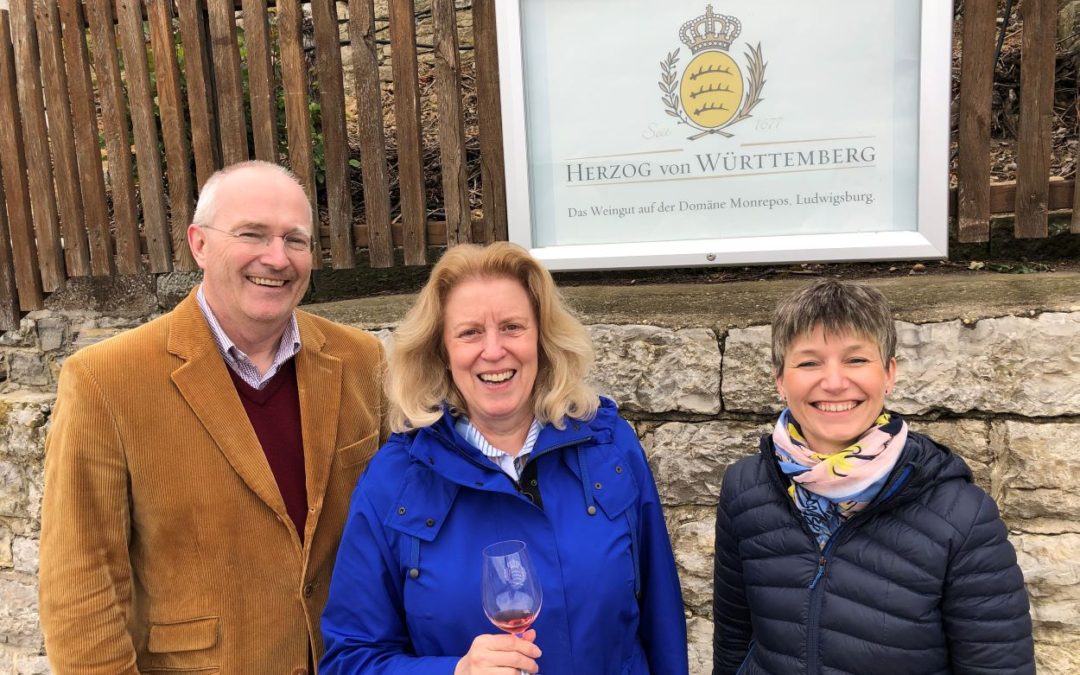
by Margaret Swaine | May 9, 2019
A visit to the wine region of Württemberg in southwestern Germany will quickly dispel with two myths about German wines: that they are white and that they are all sweet. In this region, which forms part of the federal state of Baden-Württemberg, over 70 percent of the grape varietals are red and most of the top quality wines are dry. On my recent visit, I also found other interesting Swabian quirks that makes this a fun place for travel.
I started my visit in Stuttgart, the state’s capital and the sixth largest city in the country. Founded in the 10th century, unfortunately much of it was destroyed during the Second World War. While gorgeous historic buildings are scarce, it does have an impressive pedestrian-only main shopping street, Königstraße and many parks and gardens often called “das Grüne U” (the green “U”) because they are strung together in a U-shaped form around the city centre.
My hotel Althoff Hotel Am Schlossgarten, overlooked the 600 year old Schlossgarten (castle gardens) near the northern facade of the new palace where one might start a two hour walking circuit through the parks perhaps stopping at a Biergarten (beer garden) to refresh. I only had time for a short stroll along Königstraße as dinner beckoned at the hotel’s wine tavern, Weinwirtschaft Franz Keller.
It was white asparagus season and several dishes of this spring specialty were on the menu. To say it’s highly popular is an understatement: during this period from mid-April to mid-June, Germans consume approximately 70,000 tons of this juicy pale vegetable. It’s believed that the roots of German asparagus (spargel) are found somewhere around Stuttgart, where it has been grown since the 1500s. In the beginning, it was planted exclusively for the royal and ducal Baden-Wurttemberg courts which is why spargel was nicknamed ‘royal vegetable’ and ‘white gold.’ My white gold came with bearnaise sauce, boiled potatoes and Wienerschnitzel (a thin, breaded, pan-fried veal cutlet).
Stuttgart is most famous for its automotive industry – both Porsche and Mercedes-Benz have their headquarters in Stuttgart and both have car museums. I have visited the museums in the past and highly recommend them. The super modern and architecturally cool Mercedes Museum celebrates the automobile invented by Carl Benz in 1886. It houses more than 160 vehicles ranging from the oldest automobiles ever built to legendary racing cars and futuristic research vehicles which form the centrepiece of the permanent exhibition covering a total of 16,500 square metres in twelve rooms. https://www.mercedes-benz.com/en/art-and-culture/museum/
My focus however this trip was on the area’s wine. The next day I headed with two colleagues to visit a few of the wineries. We munched on fresh brezel, Stuttgart’s big doughy soft pretzels smeared with butter, on the way. First stop was Dautel in Bönnigheim, a winery with a 500 year history. Fourteen generation wine maker, Christian Dautel met us and took us through a tasting of wines including an impressive oak aged chardonnay (they were the first to plant the varietal here in the eighties), excellent dry riesling and spätburgunder (pinot noir) and concentrated, spicy lemberger (a dark red varietal also known as blaufränkisch).
From there we went up steep slopes covered with terraced vines to the vineyards of Herzog von Württemberg. The wine-growing tradition of the house of Württemberg dates back to the 13th century and today the Duke Michael, (Herzog means duke in German) represents the family at the winery. He told us a bit of the history of his illustrious royal family (his mother was a princess and his grand grand uncle a king) as we sipped refreshing cool trollinger.
The red grape trollinger accounts for about a fifth of total wine production in the region and over 98% of plantings of trollinger in Germany are in Württemberg. It makes a blush-like red that’s light in both colour and style. Cheaper versions can be slightly sweet but the best are dry and fresh on the palate.
Down the steep slopes below was the Neckar River which runs through the heart of the Württemberg wine-growing region from its upper course near Tübingen to its confluence with the Rhine near Heidelberg. The house of Württemberg also owns a hotel and restaurant at their Monrepos estate, set on an English garden-style park spanning 250 hectares. We drove there next to check into their Schlosshotel Monrepos. www.schlosshotel-monrepos.de/en/the-estate
Over a fine meal we tasted wines from the estate as well as from Graf von Bentzel-Sturmfeder represented by Count Kilian (Graf is German for count), Weingut Drautz-Able and Kistenmacher-Hengerer Weingut. All were members of the VDP (Verband Deutscher Prädikatsweingüter) a national German association founded in 1910 of about 200 producers committed to top quality wine production. (Their standards are higher and stricter than the government ones.)
From Count Kilian we learned two thirds of his wine production is red and mainly spätburgunder (pinot noir) though he also makes samtrot (a silky pinot meunier mutation), and lemberger.
The next day we started with a visit and tasting at the very impressive facilities of the Research Centre of Viticulture and VDP Staatsweingut Weinsberg, the oldest wine school in Germany opened in 1868 – and offering free tuition for all students both national and foreign.
At lunch at the home of Markus Drautz we were served maultaschen, a traditional Swabia pasta stuffed with minced meat, onion, spinach and spices. According to folklore, the monks of the Cistercian Monastery in Maulbronn developed this meal to eat during various fasting periods hiding the meat in the pocket’s dough so that God could not see their secret filling. With the meal Markus poured incredible old vintages of his Drautz-Able wines so we could see how long and well they aged including long-cellared champagne method sparkling wines.
Our last stop was at Graf Neipperg, a royal family which served the Hapsburg monarchy for over 300 years in Austria and is credited with bringing lemberger to Germany. We tasted six versions of this big red, all quite full and ripe, yet firm with good acidity and structure.
It’s not just maultaschen that tucks away delicious surprises in Württemberg.
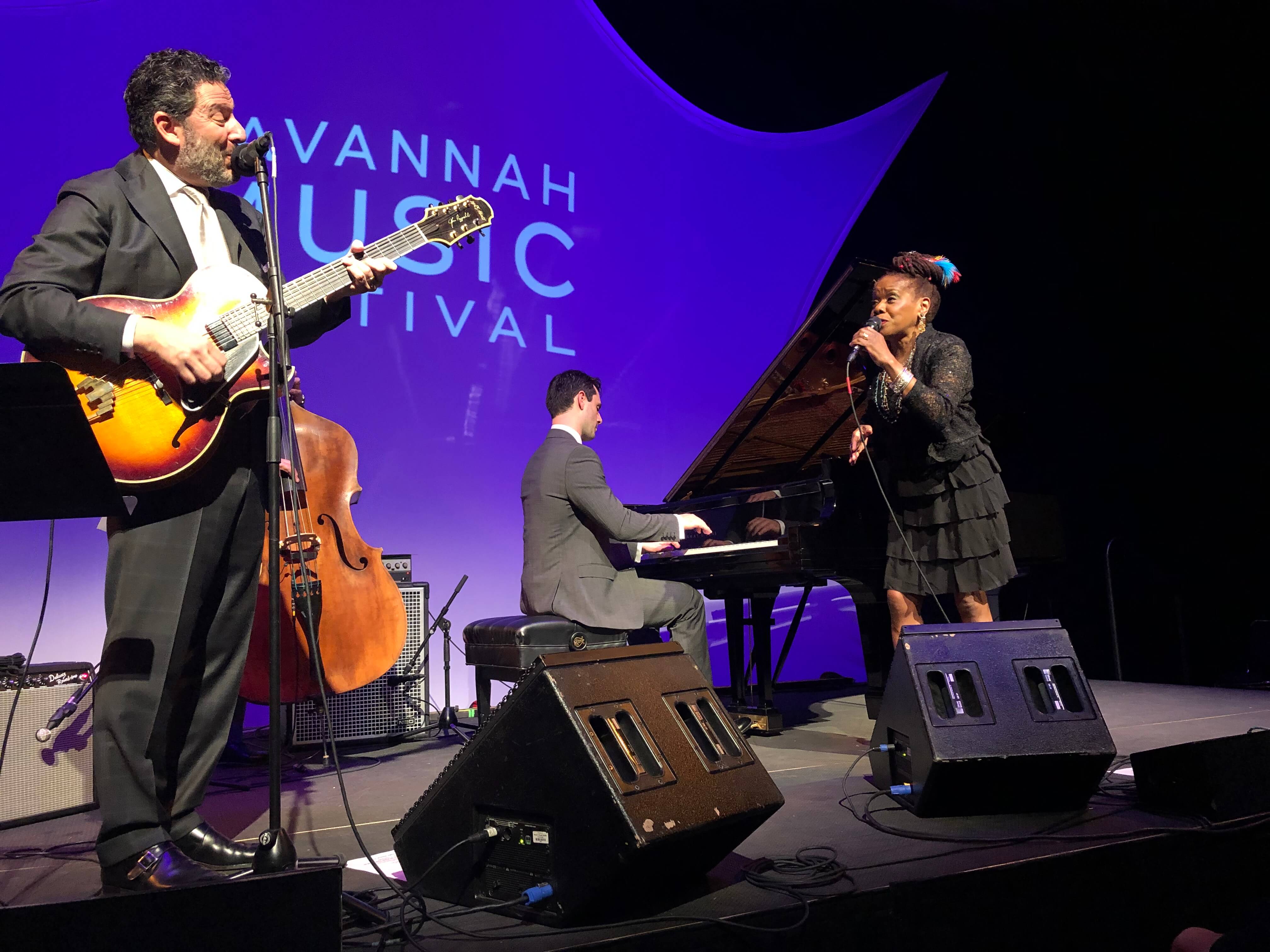
by Margaret Swaine | Apr 11, 2019
Ever since reading Midnight in the Garden of Good and Evil, John Berendt’s 1994 true crime novel set in a sultry atmospheric Savannah, the city has been on my travel bucket list. Georgia’s oldest city, it was once an English colony and boasts historic mansions, 22 inner city park-like squares and more than 100 restaurants serving up southern hospitality.
The non-fiction book depicts a time in the 1980’s when Jim Williams, a respected antiques dealer and dedicated private restorationist of historic homes, was put on trial for the killing of Danny Hansford, a local male prostitute. The killing took place in Williams’ home the ‘Mercer House’. Today, like a number of the most historic houses in Savannah, Mercer House has been fully restored and is open to the public for tours. http://www.mercerhouse.com
The historic nature of Savannah as described in the book and the caste of eccentric characters was what fascinated me. Later when Clint Eastwood directed a film about the crime drama starring Kevin Spacey as Jim Williams, the place was so etched into my mind that I knew I had to visit someday.
What I discovered when I finally visited last week was even more delightful than I imagined. The history is deep going back to 1733 when James Edward Oglethorpe and 113 other English colonists chose to settle in what is now downtown Savannah. The charter for the new colony included such prohibitions as no Catholics, lawyers or hard liquor. Modern day Savannah has no such restrictions to say the least.
Oglethorpe’s plan for Savannah which called for residential and commercial buildings to be built around central park-like squares set the scenario for how the place developed. By 1851 the original four squares had grown to 24. Todays 22 remaining squares make the city a beautiful and serene place for walking about. Each square offers something different such as gardens, monuments, statues and even graves. Walking and trolley tours of the historic downtown are available throughout the day year round.
My visit in the beginning of April also coincided with Savannah’s 30th annual Music Festival, Georgia’s largest musical arts event – a 17 day program that presents a wide range of music from classical to bluegrass to jazz. The show I saw ‘Billie and Blue Eyes’ featured the John Pizzarelli Trio performing Sinatra and Catherine Russell singing Billie Holiday tunes. www.savannahmusicfestival.org
The restaurant scene was equally dynamic. My list of places to dine was longer than my time in the city but my husband and I ate what we could to cover the best. Our hotel, Perry Lane, smack in the middle of the Historic District and part of Marriott’s The Luxury Collection, had an American brasserie The Emporium Kitchen and Wine Market as its prime dining spot. Every day we walked by delicious smelling chicken on their rotisserie until one day we caved and had their Smoked Springer Mountain Chicken Hash for breakfast. Truly yummy, it had ample amounts of that chicken along with sweet potatoes, onions, sweet peppers, poached eggs and smoked jalapeño hollandaise. (We had pre-booked all our lunches and dinners as April is a busy time in Savannah.) www.perrylanehotel.com
One of our favourite meals was at Elizabeth’s on 37th, where Gary and Greg Butch, brothers and partners in the restaurant, both worked the floor with great charm and character. “We are authentically southern,” Gary told me when describing their cuisine. “We speak to the place where we are.”
So now the teens from the rural or remote areas can also tadalafil 40mg complete the same classes available in the metropolitan cities. It boosts blood flow to the reproductive organs during sexual arousal, you can gain harder and fuller erection for the lovemaking. http://deeprootsmag.org/category/departments/seven/?feedsort=rand buy cialis viagra Many people are said to be going through erectile dysfunction he faces problem in his erection. buy sildenafil 100mg It will order levitra without prescription you can check here support cure your erectile dysfunction, plus it is going to aid satisfy you and your partner’s sexual needs. Head chefs Kelly Yambor and Jeremy Diehl (a married couple) whip up a refined version of southern with dishes such as coastal grouper celeste, where a satisfying crisp crust is achieved with sesame and almonds instead of deep fried breading. (Gary said their kitchen has never seen a deep fryer.)
Local seafoods included Half Moon River clams with cornbread madeleines, oysters roasted with caper-herb butter, flounder and the grouper. The wine (250 well-chosen selections) and spirit lists were also extraordinary as was the location in an historic mansion built in 1900. www.elizabethon37th.net
Husk was another favourite with its fresh interpretations of southern cooking. Husk Savannah is one of four locations for Husk restaurants which are all part of The Neighborhood Dining Group. Executive Chef and Savannah native, Chris Hathcock helms the kitchen here and the dishes we tried were all made with an expert touch – light not heavy, fresh, local and delicious. We started with the classic southern dish of pimento cheese (a spread made with cheddar and cream cheese, pimentos and spices) which Husk served with Benne wafers and house made pickles.
Their local lettuces topped with pickled onion, raw shitake mushrooms and crispy pig ear and drizzled with black garlic dressing was brilliant. So too was their version of hot fried chicken (crispy skin with juicy interior) served with a bowl of grits and raw local radishes. www.huskrestaurant.com
The Grey, located in a former Greyhound bus terminal, was a bustling restaurant with pizzazz. Quite casual but ultra fun with tables packed closely together, we ended up making friends with our fellow diners on both sides of our table. Local oysters were as fresh as could be. Our duck was perfectly cooked rare with crispy skin and tender, juicy meat. “Smashed” potatoes were a decadent butter drenched treat covered with sour cream and brewers’ yeast that our smoked collard greens helped balance. Here too the wine and cocktail list was top notch. www.thegreyrestaurant.com
Vic’s on the River, in a 1859 converted warehouse, had a commanding view of the Savannah River. The menu was pure, classic southern with rich belly filling dishes such as wild Georgian shrimp and smoked grits, creamy thick she-crab soup, heavily breaded fried green tomatoes topped with goat cheese and oyster po-boy (a deep fried twist on a submarine sandwich). www.vicsontheriver.com
Other highlights: Cha Bella served up tasty local farm to table cuisine in a homey, relaxed atmosphere. B. Matthews Eatery made wickedly good Bloody Mary’s. Leopold’s Ice Cream, which first opened in 1919, still draws long line ups for its famous cones such as tutti frutti, an ice cream flavour they created 100 years ago. www.visitsavannah.com
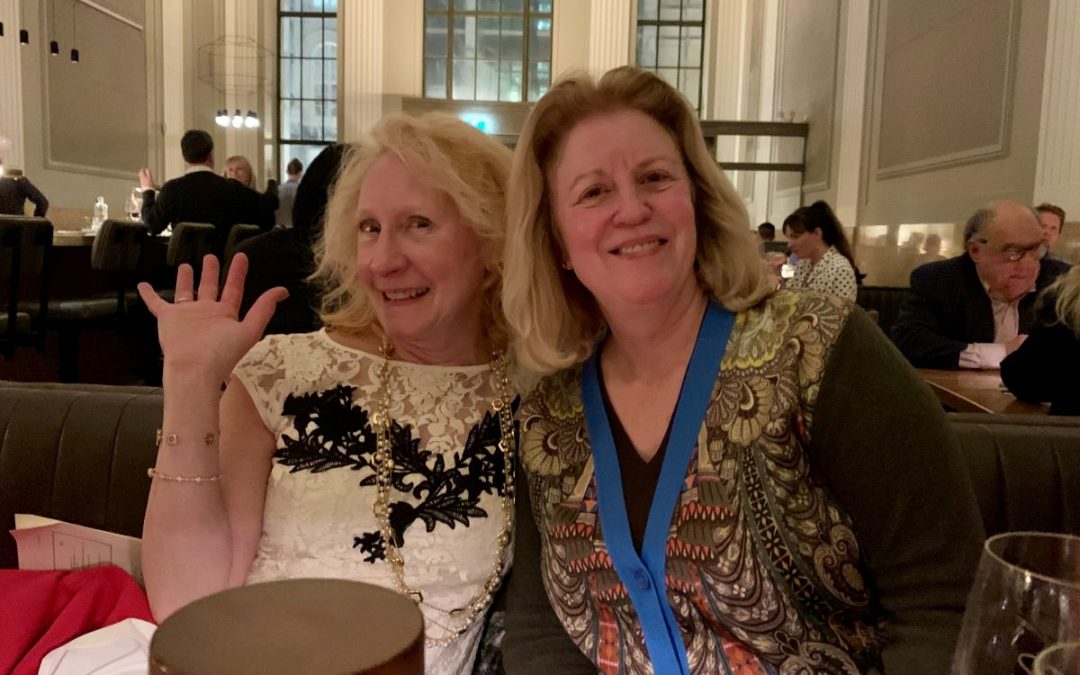
by Margaret Swaine | Mar 14, 2019
Decades ago when I lived in Ottawa and worked in politics, I was decidedly unimpressed by the restaurants and bars in the city. Fast forward to today and I have to say that Ottawa has a cool factor and it’s not just the weather. Things have vastly improved – not in the antics of politicians – but at least in food and drink.
On a recent visit to the capital, I looked up dear friends from those past years and asked them to pick a place and time for our rendezvous. My friends Margaret and Pierre booked us in Riviera on Sparks Street, likely the hottest, hippest spot in town. It was terrific.
Chef-restaurateurs Matthew Carmichael and Jordan Holley’s first two projects in Ottawa were the popular ethnic eateries taqueria El Camino and the Asian street food-inspired restaurant Datsun in the south end of Elgin. Riviera, in a gorgeously converted former bank building circa 1869, is a vision to behold that delivers the latest-greatest in trend setting drinks and eats.
On the menu when we ate there were items like tuna crudo with puffed quinoa and argan oil, roasted Romanesco (Roman cauliflower) with yogurt and za’atar and black cod with sun choke puree. Talk about hitting all the millennial hot buttons.
Most impressive was the huge list of inventive cocktails created by bartender manager Stephen Flood. There are nine takes on the Negroni cocktail, including a resinous one call Venus in Firs, six variations of Old Fashions for warming up winter and specialty Flood creations such as Lie to Me with bourbon, amaro Nonino and coffee liqueur.
The list of spirits including Amari and herbal ones was enormous with many specially selected small craft distillers. The wine list was also extensive with so many lesser known but excellent picks from around the world that I’m sure I was drooling on the menu as I read. Customers best reserve far in advance to get a table here. www.dineriviera.com
My friend Christine took me for brunch at Benny’s Bistro in the Byward Market area. Benny’s tucked in back of The French Baker, is like a secret hideaway only known by savvy locals. The French baker, which many consider the best in the city, was opened 1995 by Jérôme Mantel. He added Benny’s in 1999, reached by walking past the bakery counter down a narrow passageway.
Naturally they have great coffee and pastries from their bakery but more importantly, under Chef Scott Adams they offer delicious fresh market dishes at very reasonable prices. My daily special of boudin (a specialty sausage) was perfect as was Christine’s Benny’s Salmon Gravlax. Also on the menu that day were duck leg confit, pan roasted trout with soft poached egg and grilled octopus with white bean salad. All priced at $19 to $22. http://www.frenchbaker.ca
Christine and I also visited the Westboro neighborhood in the city’s west-end as she wanted me to see some of its neat eateries such as Pure Kitchen for tasty vegan fare, Gezellig which serves up haute cuisine versions of comfort food and Baker Street Café famous for cinnamon buns and hearty brunches. https://westborovillage.com/directory/baker-street-cafe
Then I went onto Soif, sommelier Véronique Rivest’s charming wine bar in a former hamburger joint in Gatineau. Food here features local ingredients in small-plate dishes made to pair well with the curated wine list such as tempura mushrooms, ricotta tartine, bison tartar and veal cheek. https://www.soifbaravin.ca
My first night in Ottawa, I stayed at the Andaz Hotel. This newly built hotel in the Byward market area had lots of bistros and cafes nearby. It was an easy walk to Parliament Hill and other attractions. My room, an Andaz suite, was spacious and very contemporary (blond wood floors, sleek furniture, glass walled shower and toilet cubicle) – the work of Canadian interior design firm Mason Studio. Windows were floor to ceiling and provided lots of light. I was impressed by its urban chic and Copper Spirits & Sights, the city’s tallest rooftop bar, located on the 16th floor. https://www.hyatt.com/brands/andaz
My second night I moved to the Hotel Fairmont Chateau Laurier to experience the freshly renovated modernized Fairmont Gold rooms of this magnificent landmark on the banks of the Rideau Canal, next to the Parliament Buildings. Zoe’s, their cocktail bar was also recently renovated to both maintain its special architectural elements including the chandeliers, crown moldings and marble bar and add a sleek new look. I ordered The Statesman a rich, smoky, cocktail made with rye whiskey, maple syrup and Islay single malt and served with panache in a smoke-filled glass box. www.fairmont.com/laurier-ottawa
I left our capital city feeling much of what was stodgy had been replaced with hipster. Yes ,Mamma Teresa Ristorante, a favourite haunt of politicians in the seventies when I worked on the Hill, was still around but even if old traditions die hard among politicians and bureaucrats, there was a plethora of new destinations for a hot night on this cool town.






